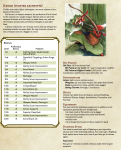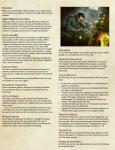Interesting you would bring up Dispel Magic.
Dispel Magic, anti-magic - magic is very much a thing in 5e, to suggest otherwise frankly borders on the quixotic.
The repeated points I keep reading are that a class should be called "warlord" from level 1 (which snubs everyone else who has to wait until 2 or 3 for their favorite class)
Every full class that was in a PH1 is a full class in the 5e PH under the same name, except the Warlord. I don't think 'everyone' is waiting to play an Assassin or Illusionist, which only appeared in past-edition PH1's as sub-classes, and are sub-classes in the 5e PH. It's a tad silly to get bent out of shape and claim being 'snubbed' for something so trivial, but, if you do want to go there, the snubbing of 4e fans by singling out the only new class presented in the 4e PH1 for exclusion is something that's long overdue to be redressed.
and the "lazylord" should be a thing again.
Hopefully not under that name, which was a charop colloquialism.

And it's the level 1 lazylord which is what causes all the problems.
Well, that's nice to know. Since that clears the Tactical, Inspiring, Resourceful, Bravura, Skirmish, and Insightful versions of wrongdoing.
As cognitive-disequilibrium inducing as a mechanic that lets one player delegate his actions to others' characters may seem, it is a nifty mechanical alternative to the 3e pacisfit for a PC that contributes in a less combative mode, and, without of the magical & clerical baggage of the pacifist, that's something that covers quite a range of genre supporting-cast types.
you would have to bring back multiple out-of-turn actions
Out of turn actions are a thing in 5e, and Rapid Attack is not the first/only way to get a little more than one Reaction going on between turns. So that doesn't seem a huge problem. Whether it requires a Reaction or not, an action-grant wouldn't disrupt the action economy, because it's 0 sum (no reaction) or negative sum (reaction required). 5 characters, 4 of which take their own actions, one of which grants his action consistently, take 5 actions, just like every other 5-character party. If a reaction is required to receive the granted action, they actually come out behind in the action economy. There's simply no danger there, at all.
Warlords were infamous for moving PC's around the battlefield
Actually, bards and invokers did no small amount of it, either, so did fighters. Not a big deal. 5e lets characters split up their move, something 4e characters couldn't do easily. There are difference between the systems, it's up to the designers to come up with the details of how to handle a concept in the slightly different action economy.
In 5e, positioning is less important than the consequences of positioning. In 4e, you might move an ally out of harms way and thus foil an attack, in 5e the move would be incidental. In 4e you might move an ally into flanking for Combat Advantage (one of many, many ways to grant CA, which didn't stack), in 5e you might simply grant Advantage (one more of many ways to grant Advantage, which doesn't stack).
No problem there.
but doing so out of turn is going to exasperate the problems listed above.
There not problems, at all, so their exacerbation should be a non-issue.
Thirdly, there is the buffing.
There's plenty of magical buffing going around in 5e, a non-magical source of it will hardly break the game. Next spurious non-issue, please.
Fourthly is the issue of scaling
Action grants scale naturally - as your allies get better, their actions get better. 'Mazing, that. Classes all advance at the same pace, so parties don't naturally diverge much in level like they did prior to 3e. As usual when it comes to scaling, BA is a third rail, so you wouldn't touch that, while hps & damage can scale like gangbusters. It sounds like a design consideration, but not a problem.
One laughable corner case - comparable to the ol bag o rats, really - that came up early in 4e diatribes, was the Stadium of Warlords. You get a few xillion low-level Warlords in a stadium cheering on their favorite gladiators and the contest turns into a blur of granted actions. Funny. Not a real issue, of course. I mean, stadium full of apprentice wizards and you can do pointlessly high damage to anything that happens to be in the stadium where their ranges overlap. Doesn't mean even one dragon has ever died that way.
But getting the class set up from level 1 is going to result in more than a bit of front-loaded ability
Nah. You no more have to give the Warlord all his cool manuevers and tactics at 1st level than you'd need to give the wizard all his spells - or even all the 1st level spells - at 1st level. A selection of the basics, improvements that are level-gated. It's not rocket science.
would be to give out debuffs, but that runs contrary to the idea of never attacking by yourself
Not really, you could distract an enemy without attacking him, for one obvious example.
And to top it all off, once you get the core class done you still have to come up with multiple subclasses, which will leave you scraping the bottom of the barrel for exclusive ideas.
There were already 6 different warlord builds in 4e, plus an archer variant, and the notorious charop lazylord. 8 sub-classes was the /most/ a full class received in the PH. The hard part will be deciding which to leave for later or consolidate.
Healing, ironically, is the least problematic of all the things they can do.
The kerfluffle about martial healing and the misrepresentation of fighters as 'casting spells' in the edition war /is/ ironic juxtaposed with the 5e fighter healing itself non-magically and, well, actually casting spells. But the edition war's over. There's nothing conceptually the Warlord needs that 5e doesn't have at least teeny, vestigial examples of here and there, it's just a matter of fleshing out all that neglected design space again and bringing back the one PH1 Core class still missing from 5e.
Fans of the Warlord have been remarkably patient. That patience doesn't mean they should continue to be excluded from the 5e family.


